CBSE Class 12th Physics paper; important concepts, how to handle difficult questions
The question paper will have five sections — Section A, Section B, Section C, Section D and Section E. The exam will be held for 70 marks and students will get three hours to complete the paper.
 CBSE Class 12 physics exam checklist (Express photo by Gurmeet Singh/ representative)
CBSE Class 12 physics exam checklist (Express photo by Gurmeet Singh/ representative)— Renuka Devi, PGT Physics, Shiv Nadar School, Faridabad
The Central Board of Secondary Education (CBSE) has concluded the Class 12 physics paper on February 21. Going by the CBSE 2024-25 sample paper, there will likely be around 30 questions. All questions in physics Class 12 paper will be compulsory. The question paper will have five sections — section A, section B, section C, section D and section E. The exam will be held for 70 marks and students will get three hours to complete the paper.
Students must be doing their last round of revision today. Here’s some points for students taking the CBSE board exam 2025 today.
CBSE Class 12 Physics: Important theoretical concepts
– Electrostatics and Current Electricity: Electric dipole, Gauss’s law and its applications, drift velocity.
– Magnetism and Electromagnetic Induction: Moving coil galvanometer, conversion of galvanometer to voltmeter and ammeter, self-induction, mutual induction, LCR circuit, AC generator, transformer.
– Optics: Refraction through spherical surfaces, prism, lens maker’s formula, compound microscope, telescope, Young’s double-slit experiment, single-slit experiment.
– Modern Physics: Atomic structure concepts such as the radius of atomic orbit and energy of an electron in orbit, PN diode, rectifier.
– Electromagnetic Waves and Magnetism: Properties of magnetic materials and characteristics of electromagnetic waves.
Essential Numerical and Graph-Based Topics
– Numericals on electric field, capacitance, and electrical circuits, magnetic field and force calculations, image formation in lenses and interference fringe width.
– Graphical and conceptual questions on variation of resistivity with temperature, photoelectric effect, including stopping potential and intensity variations.
– De Broglie wavelength, binding energy curve, and potential energy of nucleons.
Chapter-wise key topics that should not be missed
– Electrostatics: Electric dipole (field, torque, and potential), Gauss’s law and its applications, capacitors and their properties
– Current Electricity: Drift velocity and its significance, Kirchhoff’s laws and their applications, Wheatstone bridge and its use in circuit analysis
– Magnetic Effects of Current & Magnetism: Biot-Savart’s law and its applications, force between two current-carrying conductors, Torque on a current-carrying loop in a magnetic field, moving coil galvanometer and its working principle
How to handle difficult/ confusing questions in physics
– Read the question carefully, if needed read it twice.
– Represent the question diagrammatically while reading the question word by word.
– List down the given quantities and the quantity which needs to be found.
– Connect them to relate relevant concepts.
– Check for the units, especially for numericals.
– In case of MCQs, eliminate the incorrect options.
– If stuck, move on to the next and come back to this question later with a fresh perspective.
(Renuka Devi is PGT Physics, Shiv Nadar School, Faridabad)
- 01
- 02
- 03
- 04
- 05































